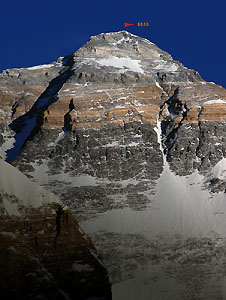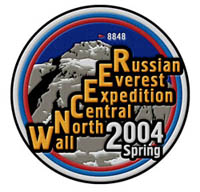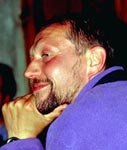|
Ïèøèòå â ÔÎÐÓÌ íà Mountain.RU

Hi-Rez
Mt. Everest, 8848ì
The North Face
The leader of the expedition
is Victor Kozlov
 The
senior coach is Nikolay Chernij The
senior coach is Nikolay Chernij
Coach: Alexander
Pyatnitsyn, Rostov - na-Donu
Doctor: Sergey Bychkovsky, Ekaterinburg
Videooperators: (up to 6200m) Igor Borisenko,
Sergey Shakunin
Photographer: Vladimir Kuptsov
Terms of the expedition: from February,
25 till June, 9, 2004
News
Participants:
 Peter
Kuznetsov, Krasnoyarsk Peter
Kuznetsov, Krasnoyarsk
 Jury
Koshelenko, Rostov-na-Donu Jury
Koshelenko, Rostov-na-Donu
 Pavel
Shabalin, Kirov Pavel
Shabalin, Kirov
 Eugeny
Vinogradsky, Ekaterinburg Eugeny
Vinogradsky, Ekaterinburg
 Jury
Ermachek, Ekaterinburg Jury
Ermachek, Ekaterinburg
 Nikolay
Zhilin, Ekaterinburg Nikolay
Zhilin, Ekaterinburg
 Andrey
Mariev, Tolyatti Andrey
Mariev, Tolyatti
 Victor
Volodin, Moscow Victor
Volodin, Moscow
 Victor
Bobok, Moscow Victor
Bobok, Moscow
 Vladimir
Arhipov, Krasnoyarsk Vladimir
Arhipov, Krasnoyarsk
 Sokolov
Gleb, Novosibirsk Sokolov
Gleb, Novosibirsk
 Ilyas
Tukhvatullin, Podolsk - Tashkent Ilyas
Tukhvatullin, Podolsk - Tashkent
 Alexey
Bukinich, Sochi Alexey
Bukinich, Sochi
Sponsors:
- Centro Credit Bank
- New Group Industrial League
- Double V GROUP
- QATAR AIRWAYS
- RedFox outdoor eqipment
- CAMP
- SONY
- InCOMa
- Via inmarsat russia marsat
- ÍÒÂ plus
- IRIDIUM Technologies
- ASIAN Trekking
- Mountain.RU
|

Russian
The information was prepared by
Anna Piunova, Mountain.RU
Expedition “Everest
Northern Face ”
On Friday, February, 20, in World trade centre
a press conference concerning forthcoming departure of the combined
team of Russia for Everest, Northern Face took place.
The list of members of the expedition - 13
person, seven from them (Kuznetsov, Koshelenko, Vinogradsky, Zhilin,
Ermachek, Volodin and Sokolov) took part in expedition of 2002 on
Lhodse Middle.
|

Viktor Kozlov
|
So,
The head of expedition - Victor Kozlov,
Moscow
|

Nikolay Chyorniy
|
Senior trainer - Nikolay Chyorniy, Moscow
Coach - Alexander Pyatnitsyn, Rostov -
na-Donu
Doctor - Sergey Bychkovsky, Ekaterinburg
Videooperators - (up to 6200m) Igor Borisenko,
Sergey Shakunin
Photographer - Vladimir Kuptsov
Heads of sports groups:
Peter Kuznetsov, Krasnoyarsk
(he was on Everest twice- the first time via the classical route,
the second -North Face first ascent, Lhotse Middle, Khan Tengri,
Pobeda peak)
Jury Koshelenko, Rostov-na-Donu
(he was nominated on Piolet d’or four times, the winner of the Piolet
d’or for the ascent on Nuptse East; first ascents on Shkhelda, Chatyn,
Erydag, Ak-Su, Khan Tengri, the Troll Wall, Bhagirathi, Petit Dru,
Trango Tower)
Pavel Shabalin, Kirov
(Ak-Su - 10 climbs; first ascent Changabang, Northern face (Garhwal,
the Indian Himalayas), Khan Tengri, Northern face; El-Captain, Asan,
Slesova peak, peak 4810, peak Svobodnaya Korea, Dallar, Ushba, peak
Korzhenevskoy, Lenin peak, Communism peak)
Participants:
Eugeny Vinogradsky, Ekaterinburg
(Everest four climbs (all with oxygen), three climbs on Cho Oyu;
Communism peak, Lenin peak, peak Korzhenevskoy, traverse of peak
Kalinina - Communism peak, Engels Peak, Northern face, Block peak,
Pobeda peak, peak Svobodnaya Korea, traverse Vazha Pshavel - Peak
Pobeda - Military topographers, traverse of Kangchenjunga; in the
autumn 1996 in a two-men team with Pershin - doublet of Shisha Pangma
-Cho Oyu).
Jury Ermachek, Ekaterinburg
(the winner of the Piolet d’or for the ascent on Makalu, Western
Face, Everest, Lhotse Middle, Pobeda peak, Khan Tengri, Northern
Face, Annapurna, Engels peak, peak 4810).
Nikolay Zhilin, Ekaterinburg
(the winner of the Piolet d’or for the ascent on Makalu, Western
Face, Khan Tengri)
Andrey Mariev, Tolyatti
(Ê2, first ascent Changabang, Northern face, Nanga-Parbat)
Victor Volodin, Moscow
(Everest, peak Urriellu, Marks peak, Engels peak, peak Korzhenevskoy,
Communism peak, Lenin Peak)
Victor Bobok, Moscow
(a high-speed ascent on peak Korzhenevskoy - 11 hours from base
camp; Shkhelda in a two-men team with J.Koshelenko, Shisha Pangma)
Vladimir Arhipov, Krasnoyarsk
(Pobeda Peak, Khan Tengri peak, peak Korzhenevskoy, Lenina peak)
Sokolov Gleb, Novosibirsk
(Lenina peak, Communism peak, peak Korzhenevskoy, high-speed solo
to Khan Tengri - 14 hours from the base camp and back, a high-speed
ascent on Communism peak from Moskvin's glade and back - 19 hours
of 40 minutes, a high-speed ascent to Lenina peak from the camp
at 4,200 m through Razdelnaya and back for 12 hours, a high-speed
ascent from Zvyozdochka (Asterisk) glacier to Pobeda peak through
Vazha Pshavel peak and back to Zvyozdochka (Asterisk) glacier -
20 hours, Makalu, Lhotse, Lhodse Sphere, Lhodse Middle).
Ilyas Tukhvatullin, Podolsk
- Tashkent (Everest, Ak-Su - 6 ascents, Khan Tengri, Northern
face)
Alexey Bukinich, Sochi,
22 years - the youngest participant of the team, experience
of ascents on "7-thousand" mountains, He has Jury Koshelenko's recommendation.
Everest. North Face.
Difference of the altitude 2,5 km
Extent of the route 4,5 km
Up to the altitude of 7200m - the rocky
zone filled with ice, then there is a snow field.
Rocks - imbricate, very slippery.
The crux is at the altitude of 7900-8500
m
Prospective altitude of the summit push
camp - 8200-8300 m
The main question: Tactics. Oxygen. Team.
The basic difficulties.
Jury Ermachek:
In March we should accomplish an acclimatization
ascent on Ama Dablam, descend to have a rest in Katmandu and at
the end of March - the beginning of April are going to move under
the Northern face of Everest. We are going to start fixing the route
straight away because it is required to a lot of time. We will have
to begin that as soon as possible, as in many respects everything
will depend on the weather. Someone will get in the good weather,
someone - in the bad weather, but it is necessary to start to work
immediately right away.
The question about spending the night on
the wall: most likely, we will adhere to the old tactics tested
on Makalu - after climbing every 10 pitches on the wall we will
have spending the night. Instead of Makalu, where there were places
to set tents, we will use a portaledge on the wall.
Oxygen - upper than 8000 meters. Probably,
some of climbers will use oxygen below. Everything will depend on
the state of member's health and their working efficiency at such
altitude. So we have understood by experience, that we can work
at high altitude without oxygen, but some climbers have not climbed
the "8-thousand" mountains. We will take oxygen on the summit push
and time will show whether to use it or no.
The structure of the team has changed.
I am familiar rather with a half of participants. Therefore it is
difficult to tell, who and how will work. I know those guys who
was with me on Lhodse Middle, but I do not know the others. …
Complexity - the high altitude, the
very high altitude. Very strong cold at this time, in the spring,
shortage of oxygen and storm winds. On Western face of Makalu there
were no winds at all - a ridge protected, but here there are very
strong winds. The constant wind exhausts both nerves, and health.
You get tired from it.
Pavel Shabalin:
The basic complexities - the extent
of the route and labour-consuming of the route, there are not easy
sites, constantly steps, which it is necessary to climb, to go on
foot; the plates are slippery and smooth. If there is not snow it
will be unpleasant very much to climb constant rocks.
Oxygen? - I, probably, the unique man who
was not on "8-thousand" mountains. We will see. I know that I am
in a very strong company, Mariev and Ilyas are the people who I
simply idolize. They are the super-climbers.
Ilyas was the last, who saw Franky (the American,
Arsentyev's wife). They gave them everything that it was possible
to give them, including oxygen. Ilyas went on the charge of half-litre
in a minute, it is night norm. What, he speaks, did I climb with
this oxygen for? Ilyas and I climbed Khan Tengri twice, and I remember
Meriev as the unique climber when we climbed Changabang together.
Andrey Mariev:
I know only four climbers from the whole team.
I have seen the others somewhere or have read about them. I think,
that there will not be any complexities.
As it seems to me, the basic problem
is a question of our survival, the survival in cold conditions,
as it will be cold and constantly cold at the high altitude. Most
likely, climbers will get some small exhaustion, and on this background
they simply will get cold. It will be difficult for me, probably.
I never worked with oxygen, therefore,
if the leader order, I will take it, but I will try to climb without
oxygen.
Ilyas Tukhvatullin:
If I climbed via the northeast ridge, I would
go without oxygen. I would like very much to try without
using oxygen, but should I risk for the sake of my personal interests?
- I am going decide that during our ascent whether I have the right
to do that? In the case of using there is a probability to chill
a throat and if I am disabled, it means, there will stay already
not 13, but 12 climbers. The team will have to work more.
And here all of us have to weigh as far as
personal ambitions, desire to breathe without oxygen above and necessity
to work with full feedback on that site which will fall to your
lot are proved. Everything needs to be balanced, and then everything
will be good.
Psychologically, I do not think, that
it will be hard. There is an opinion, that when the great climbers
gather in a team - and here I can see the stars of the Russian mountaineering
– it is very difficult to lead it. Everyone has own opinion, asserts
it and so on … Probably, that the leaders will have problems with
management of the team, it is possible, but the main task, the purpose,
I hope, will correct ambitions some people separately as the persons,
and will turn all of us to work in a command.
Already it is clear, that the probability
of the majority of us will summit is minimal. Therefore we should
realize, that it would be the team of two or the four, a maximum
six climbers. All others will work for realization of this way,
Russian way on the Northern Face. It is the psychological moment,
which, probably, will render shadow influence on a course of events.
Technical? The route is very complex
technically. It is complex so much, that I do not want to estimate
it now on any parameters at all. The attitude should be very simple
- we go there to live, to live for 100 days, in a good team, with
good people, and to try to realize a good idea. That's all. The
rest things will depend on many factors, including the weather.
If the weather is good, we will do our best and do everything, that
we can, and it can be even hardly more, as all the professionals
are practically here, and they know their business. And let see,
as it will turn out.
About tactics: The route is combined.
There are also easy extended sites (high-altitude ascending). But
there are enough abrupt sites for high-altitude mountaineering in
the beginning and, the most important thing, above, right before
the summit, where anybody from us has not "felt" the Wall, although
below the guys made the route reconnaissance, and all of us can
imagine, what we are going to run into. Here, there are two technical
things.
Spending the night. We have thought
up how to install the camps for spending the night. It is unreal
to hang a portaledge, as it is too hard. We decided to use fishing
nets, if we bolt them to the wall, caulk up this space with snow
and freeze, we can set on this platform our tents.
The main thing, I am personally not so well
familiar with avalanche situation on this part of the wall, how
the wall, the base and next camps are protected from snowfalls.
I want to find it out, to observe already on road the route. The
average zone as you can see is white, with a lot of snow, with rather
big accumulation of snow in places. And I do not like that. I am
a rock-climber, a technical climber, and I have come here to work
on rocky sites, where the only high-altitude climbers do not work.
Therefore Pavel Shabalin and I take with us all necessary technical
equipment. Jury Koshelenko and, basically, more than a half of the
team members have a fine operational experience on abrupt sites.
It allows hoping that under certain conditions, weathers and etc,
we have a chance to successfully climb this route.
Victor Volodin:
The biggest problem? - My family  . The main thing is that the family will survive without me here
. The main thing is that the family will survive without me here
 . .
There are the heroes who should fix the rope,
and there are the wise people who should climb on them - whenever
it is possible  . We have got two jumars so with them we will be able to climb in
any way
. We have got two jumars so with them we will be able to climb in
any way  . .
Oxygen? It seems the real Wall, it would be
hard to climb without oxygen, I think. I would not take it if we
were going to climb via classical route …
Ermachek-Volodin:
If you ask us about dopes - we as the Soviet
people will reject any dope preparations. We will have necessary
analysis. Instead of those football players and hockey players who
eat tablets to support the health and to show result we will work
supporting exclusively by a factory "Crystal"  (the famous liqueur-vodka factory in Russia).
(the famous liqueur-vodka factory in Russia).
By the way, do you take it a lot from the
factory?
It is our military secret. Let other people
be tormented how much the Russian can drink on the Northern Face
of Everest  .
.
|

